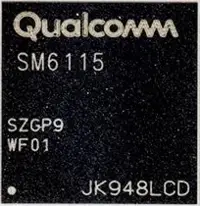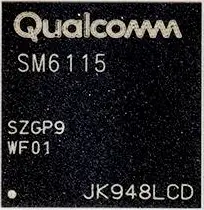From WikiChip
Snapdragon 662 - Qualcomm
| Edit Values | |
| Snapdragon 662 | |
 | |
| General Info | |
| Designer | Qualcomm |
| Manufacturer | Samsung |
| Model Number | Snapdragon 662 |
| Part Number | SM6115 |
| Market | Mobile |
| Introduction | January 20, 2020 (announced) January 20, 2020 (launched) |
| General Specs | |
| Family | Snapdragon 600 |
| Frequency | 1,800 MHz, 2,000 MHz |
| Microarchitecture | |
| ISA | ARMv8.2 (ARM) |
| Microarchitecture | Cortex-A73, Cortex-A53 |
| Core Name | Cortex-A73, Cortex-A53 |
| Process | 11 nm |
| Technology | CMOS |
| Word Size | 64 bit |
| Cores | 8 |
| Threads | 8 |
| Max Memory | 8 GiB |
| Multiprocessing | |
| Max SMP | 1-Way (Uniprocessor) |
Facts about "Snapdragon 662 - Qualcomm"
| base frequency | 1,800 MHz (1.8 GHz, 1,800,000 kHz) + and 2,000 MHz (2 GHz, 2,000,000 kHz) + |
| core count | 8 + |
| core name | Kryo 260 Gold + and Kryo 260 Silver + |
| designer | Qualcomm + |
| dsp | Hexagon 683 DSP + |
| family | Snapdragon 600 + |
| first announced | January 20, 2020 + |
| first launched | January 20, 2020 + |
| full page name | qualcomm/snapdragon 600/662 + |
| has ecc memory support | false + |
| instance of | microprocessor + |
| integrated gpu | Adreno 610 + |
| integrated gpu designer | Qualcomm + |
| isa | ARMv8.2 + |
| isa family | ARM + |
| ldate | January 20, 2020 + |
| main image |  + + |
| manufacturer | Samsung + |
| market segment | Mobile + |
| max cpu count | 1 + |
| max memory | 8,192 MiB (8,388,608 KiB, 8,589,934,592 B, 8 GiB, 0.00781 TiB) + |
| max memory bandwidth | 13.91 GiB/s (14,243.84 MiB/s, 14.936 GB/s, 14,935.749 MB/s, 0.0136 TiB/s, 0.0149 TB/s) + |
| max memory channels | 2 + |
| microarchitecture | Cortex-A73 + and Cortex-A53 + |
| model number | Snapdragon 662 + |
| name | Snapdragon 662 + |
| part number | SM6115 + |
| process | 11 nm (0.011 μm, 1.1e-5 mm) + |
| smp max ways | 1 + |
| supported memory type | LPDDR4X-3733 + |
| technology | CMOS + |
| thread count | 8 + |
| used by | Motorola Moto G9 Play + |
| word size | 64 bit (8 octets, 16 nibbles) + |